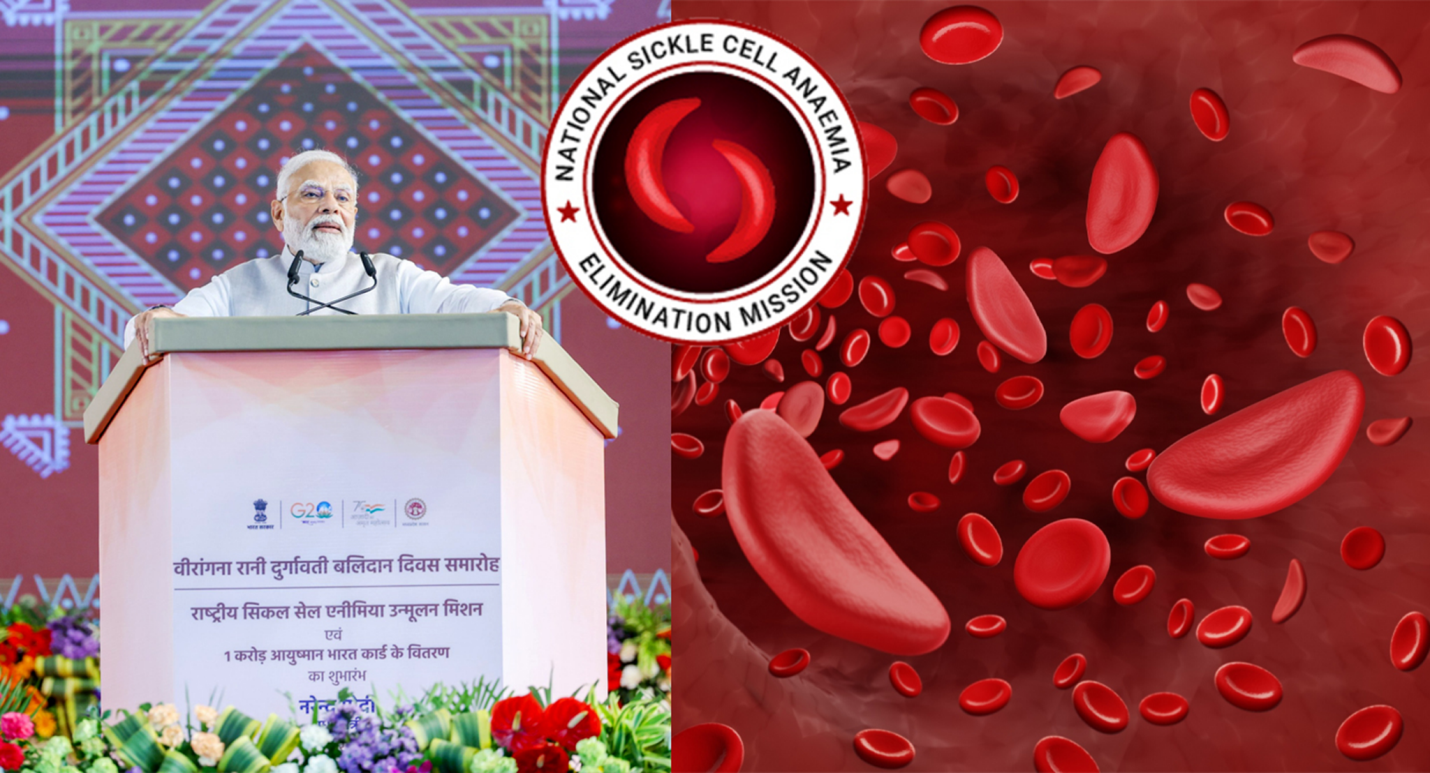Description

Copyright infringement not intended
Context: The Prime Minister of India recently inaugurated the National Sickle Cell Anaemia Elimination Mission (NSCAEM) in Shahdol, Madhya Pradesh. He also handed over sickle cell genetic status cards to the beneficiaries, which will help them access timely diagnosis and treatment.
Details
- Sickle cell anaemia is a hereditary blood disorder that affects the red blood cells, causing them to become rigid and sickle-shaped. This impairs their ability to carry oxygen and leads to various complications such as pain, infections, organ damage and anaemia.
Sickle Cell Anaemia (SCA)
About
- Sickle cell anaemia (SCA) is a genetic disorder that affects the shape and function of red blood cells (RBCs), which carry oxygen to all parts of the body.
- Normally, RBCs are round and flexible, but in SCA, some of them are shaped like sickles or crescent moons. These sickle cells are rigid, sticky and prone to getting trapped in small blood vessels, blocking blood flow and causing pain, tissue damage and organ failure.
- SCA is one of the most common inherited blood disorders in the world, affecting millions of people, especially those of African, Asian and Mediterranean descent.
- In India, SCA is prevalent in some tribal and non-tribal communities in states like Maharashtra, Madhya Pradesh, Chhattisgarh, Gujarat, Odisha, Jharkhand and Bihar. According to a 2018 report by the Indian Council of Medical Research (ICMR), about 1.2% of the Indian population has sickle cell trait (SCT), which means they carry one copy of the mutated gene that causes SCA.
- People with SCT usually do not have any symptoms, but they can pass on the gene to their children. If both parents have SCT, there is a 25% chance that their child will have SCA.
Challenges and the way forward
- SCA is a lifelong condition that has no cure for most people. However, it can be managed with proper diagnosis, treatment and care.
- Early screening and counselling can help identify people with SCT and SCA and provide them with genetic education and reproductive options.
- Regular blood tests and check-ups can monitor the health status and complications of people with SCA. Medications such as hydroxyurea, painkillers and antibiotics can help reduce the frequency and severity of pain crises, infections and other complications.
- Blood transfusions and bone marrow transplants can also be used in some cases to treat severe anaemia and prevent strokes.
- Lifestyle modifications such as drinking plenty of water, avoiding extreme temperatures and stress, and getting adequate rest and exercise can help improve the quality of life of people with SCA.

National Sickle Cell Anaemia Elimination Mission
About
- The NSCAEM aims to eliminate sickle cell anaemia from the country by 2047, the 100th year of India's independence.
- The mission will create awareness among the public and health workers about the prevention and management of sickle cell anaemia.
- It will reduce the morbidity and mortality associated with sickle cell anaemia, and enhances the quality of life of the affected individuals and families.
- It will also contribute to the achievement of the Sustainable Development Goals related to health, education and social inclusion.
The mission has four main components:
Screening
- All newborns and pregnant women will be screened for sickle cell trait or disease using a simple and rapid test. Those who are found positive will be given a genetic status card, which will help them in accessing appropriate health care and counselling services.
Prevention
- Couples who are carriers of sickle cell trait will be counselled about the risk of having a child with sickle cell disease and the available options for prevention. Prenatal diagnosis and medical termination of pregnancy will be offered to those who wish to avoid having an affected child.
Treatment
- Patients with sickle cell disease will be provided with free and regular treatment, including blood transfusions, hydroxyurea therapy, pain management and antibiotics. They will also be enrolled in a national registry, which will help in monitoring their health outcomes and quality of life.
Research
- The mission will support research and innovation in the field of sickle cell anaemia, such as developing new drugs, vaccines, gene therapy and stem cell therapy. It will also promote awareness and education among the public and health professionals about the disorder.

Challenges in its implementation
Lack of awareness and stigma
- Many people are unaware of their sickle cell status or the implications of the disorder. They may also face discrimination and social exclusion due to their condition.
Shortage of resources
- The mission requires adequate funding, infrastructure, manpower and blood supply to ensure effective screening, prevention and treatment of sickle cell anaemia.
Ethical and legal issues
- The mission involves sensitive issues such as genetic testing, prenatal diagnosis, abortion and gene editing, which may raise ethical and legal concerns among some sections of society
Coordination and collaboration
- The mission requires coordination and collaboration among various stakeholders, such as central and state governments, health departments, civil society organizations, research institutions and international agencies.
To overcome these challenges, the NSCAEM needs to adopt a multi-sectoral and multi-stakeholder approach that involves collaboration among various ministries, departments, agencies, organisations, institutions, communities and individuals.
Some of the Possible Strategies are:
- Strengthening the existing network of sickle cell centres across the country, which provide comprehensive care and support to patients and families.
- Expanding the coverage of screening programmes to reach all newborns and pregnant women, using simple and affordable methods such as paper-based tests or mobile apps.
- Providing free or subsidised treatment to all patients who need it, including drugs, blood transfusions, hydroxyurea therapy and bone marrow transplants.
- Developing new therapies and technologies that can cure or prevent sickle cell anaemia, such as gene therapy or gene editing.
- Creating a national registry and database of sickle cell patients and carriers, this can help monitor the progress and impact of the mission.
- Engaging with various stakeholders, such as community leaders, religious groups, media outlets, NGOs and international organisations, to raise awareness and mobilise support for the mission.
- Conducting regular surveys and evaluations to measure the outcomes and challenges of the mission.
Conclusion
- The National Sickle Cell Anaemia Elimination Mission is a commendable initiative that reflects the commitment of the Prime Minister of India to free the tribal communities and the country from the menace of sickle cell anaemia by 2047. It is hoped that with collective efforts and cooperation, this mission will succeed in its noble objective and create a healthier and happier India.
Must-Read Articles:
NATIONAL SICKLE CELL ANAEMIA ELIMINATION MISSION: https://www.iasgyan.in/daily-current-affairs/national-sickle-cell-anaemia-elimination-mission
|
PRACTICE QUESTION
Q. What is the best way to cure Sickle Cell Anaemia?
A) Bone marrow transplant
B) Gene therapy
C) Stem cell therapy
Choose the correct code;
A) 1 and 2 only
B) 2 and 3 only
C) 1 and 3 only
D) 1, 2 and 3
Answer: D
Explanation: The best way to cure sickle cell anaemia is to replace the defective haemoglobin gene or cells with normal ones. This can be done by various methods, such as bone marrow transplant, gene therapy, or stem cell therapy. However, these methods are not widely available, have risks and limitations, and require a compatible donor.
|

https://www.pib.gov.in/PressReleasePage.aspx?PRID=1936690

















